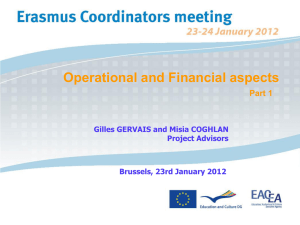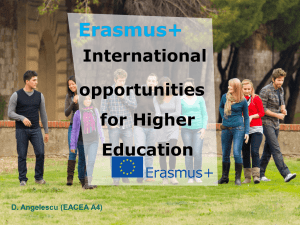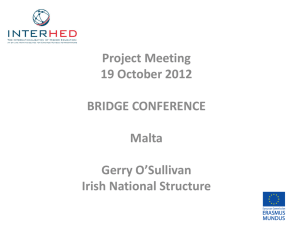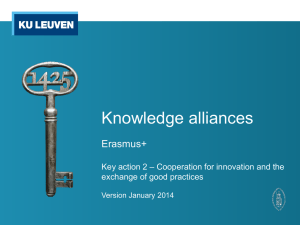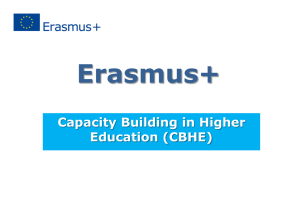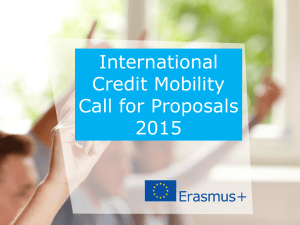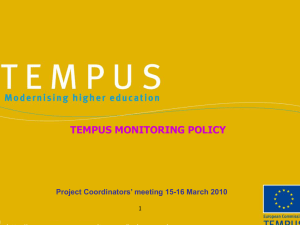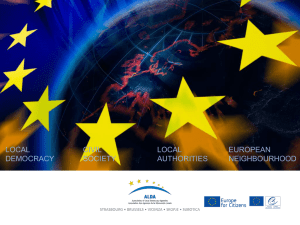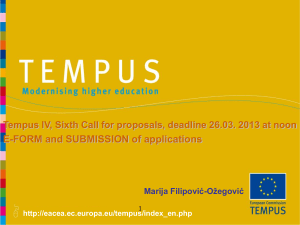Sector Skills Alliances - NA-LLL
advertisement
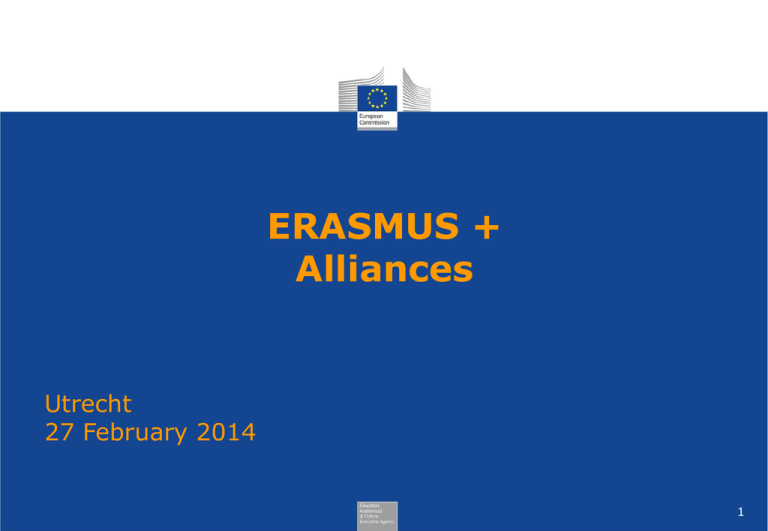
ERASMUS + Alliances Utrecht 27 February 2014 1 EACEA - The old portfolio 2007-2013 Lifelong Learning Programme •Erasmus •Leonardo da Vinci •Grundtvig •Comenius •Transversal: Key Activites 1 – 2 – 3 – 4 •Jean Monnet •(Eurydice) Erasmus Mundus Tempus Europe for Citizens 2 EACEA - The new portfolio 2014-2020 • • • • • • • Higher Education (EU and International) Vocational Education and Training Adult Education School Education Policy Support Jean Monnet (Eurydice) 3 4 Commission and EACEA - Partners with complementary roles Policy - DG EAC - DG COMM - DG ECHO • • • • • Policy documents Programme definition Call Priorities Committees Impact analysis Programme implementation • Management of centralised actions • Whole project life-cycle • Results & feedback • ~400 staff • Based in Brussels • Management: EC officials Management of decentralised actions via National Agencies 5 Unit EACEA – A5 Vocational Education, Adult Education, Platforms • • • • • • • Sector skills Alliances Thematic network Workbased Learning (WBL) and Apprenticeships Specific call to National Authorities on WBL and Appr. Adult Learning National contact points EPALE platform (CSS and NSS) Etwinning platform (CSS and NSS) Legacy: – Leonardo da Vinci – Grundtvig – KA-4 6 A streamlined architecture : 3 Key actions Existing programmes Lifelong Learning Programme Grundtvig International higher education programmes: Erasmus Mundus, Tempus, Alfa, Edulink, Bilateral Programmes Erasmus+ 1. Learning Mobility Erasmus Leonardo Comenius A single integrated programme 2. Co-operation projects 3. Policy Support Youth in Action Programme Specific activities: • Jean Monnet • Sport 3 main types of Key Action Learning mobility of individuals (KA1) Staff mobility, in particular for teachers, lecturers, school leaders and youth workers Mobility for higher education students, vocational education and training students Student loan guarantee Joint Master degrees Mobility for higher education for EU and non-EU beneficiaries Volunteering and youth exchanges Cooperation for innovation and exchange of good practices (KA2) Strategic partnerships between education/training or youth organisations and other relevant actors Large scale partnerships between education and training establishments and business: Knowledge Alliances & Sector Skills alliances IT-Platforms including e-Twinning Cooperation with third countries and focus on neighbourhood countries Support for policy reform (KA3) Open method of Coordination Prospective initiatives EU recognition tools Dissemination & exploitation Policy dialogue with stakeholders, third countries and international organisations What are Alliances • Big international cooperation projects • Innovation • High impact to the systems • Sustainable cooperation • Education and training links with business What is a Sector Skills Alliance • Sector based • tackling skills gaps • enhancing the responsiveness of VET systems to sector-specific labour market needs with regard to one or more occupational profiles What Sectors A sector=economic sector/branch (NACE codes) Only some sectors eligible under call 2014: included in European Sector Skills Council, namely: textile/clothing/leather, commerce; sectors with skills imbalances: advanced manufacturing, ICT, environmental technologies (Eco-Innovation), cultural and creative sector 11 Main objectives VET modernisation, competiveness of sectors Exchange VET-labour market, work based learning Recognition at European level, increased mobility 12 Which Activities are supported Defining skills and training provision needs Joint curriculum design Joint curriculum delivery mobility Defining skills and training provision needs • Gathering and interpreting of skills needs (were possible draw on EU Skills Panorama) • Identifying needs in terms of training provision Joint curricula design • Designing EU sector-specific curricula, VET programmes, qualification standards (where basing on ESCO – European Skills, Competences, Qualifications and Occupations) Joint curricula design (2) • Integrating skills/occupational profiles into curriculum design • Apply learning outcomes approach (e.g. EQF, ECVET) • Innovative approaches to teaching, learning (e.g. ict, open educational resources, real life workplace situations, entrepreneurial mind-sets) Joint curricula delivery • Delivering (adapted/newly created) EU sector-specific curricula • Impelmenting innovative VET methods (ICT, work-based etc.) • Recognition, certification of learning outcomes (e.g. ECVET, EQAVET) European Qualification Framework Application of European reference tools European Quality Assurance Framework for VET Learning Outcomes Approach European Credit System for VET Who can participate • Eligible participating organisations (from Programme countries and Partner countries. Partner country MUST bring added value.) • Participating organisations: Full partners (contractual requirements=contract) + (optional) Associated partners (NO contract) Who MUST participate At least one organisation from each of the following three categories in each of the Vocational Education & countries involved Training in the Alliance providers Partners representativ e in sector with sector– expertise/Res earch (if needed) Bodies (with regulatory function) responsible for qualifications/ certification/ accreditation KNOWLEDGE ALLIANCES KNOWLEDGE ALLIANCES What are they: Partnerships between HEI institutions and enterprise that aim to promote creativity, innovation and entrepreneurship by offering new curricula, learning opportunities and qualifications. Main activities: •Delivery of new multidisciplinary curricula responding to business needs •Stimulate entrepreneurship and entrepreneurial mind-set of students, academic and company staff •Facilitate the exchange, flow and co-creation of knowledge between HEIs and enterprises Knowledge Alliances: Cooperation and Innovation Higher Education Research Business Overall objective Strengthen Europe's innovation capacity Foster innovation in higher education, enterprises and socio-economic environment 23 Objectives Develop innovative ways of teaching, learning and governance Stimulate entrepreneurship and entrepreneurial competence of students, academics and company staff Strengthen the flow and exchange of information and knowledge Stimulate the co-creation of knowledge Stimulate the cooperation between higher education institutions and companies 24 WHICH ACTIVITIES ARE SUPPORTED? Sustainability of universitybusiness cooperation Impact beyond the project's lifetime Boosting innovation in higher education, business and in the broader socio-economic environment Developing entrepreneurship mind-set and competences Stimulating the flow and exchange of knowledge between higher education and enterprises 25 Activities - A consistent and comprehensive set of activities Development and implemetation of new learning and teaching methods Develop and deliver new and innovative study programmes Organisation of continuing educational programmes and activities with and within companies Schemes of transversals skills' learning in cooperation with enterprises Entrepreneurship education in any discipline Study field related activities which are embedded in curricula Exchange of students, researchers, teaching and company staff Etc. 26 Who can participate • Eligible participating organisations (from Programme countries and Partner countries. Partner country MUST bring added value.) • Participating organisations: Full partners (contractual requirements=contract) + (optional) Associated partners (NO contract) How to participate Sector Skills Alliance • Number of partners (9 organisations from at least 3 Programme countries, including at least two EU Member States. Organisation can only be involved in one SSA application) • One of 6 sectors • Duration of the project 2/3 years • Deadline 3/04/2014 midday CET. • Apply to EACEA. • Applications prepared using official templates. • Proposal concerns one of the eligible sectors. Knowledge Alliance • At least 6 organisations from 3 different Programme Countries • At least 2 higher education institutions and 2 companies • HEI –Erasmus Charter • Duration of the project 2/3 years • Deadline 3/04/2014 midday CET. • Apply to EACEA. • Applications prepared using official templates. 28 Award criteria • Relevance of the project • Quality of the project design and implementation • Quality of the project team and the cooperation arrangements • Impact and dissemination 29 Funding rules Maximum EU grant: 2 years(700 000 EUR), 3 years (1 000 000 EUR) Budget based on unit costs (staff input) Mobility costs (if applicable): units of travel and subsistence costs Target: Up to 150 Knowledge Alliances by 2020 Up to 150 Sector Skills Alliances by 2020 30 FUNDING RULES Max EU contribution for 2-year project: 700 000 EUR Max EU contribution for a 3-year project: 1 000 000 EUR Eligible costs: implementation support activities Financing system: unit costs Amount: different categories of staff Unit Cost financing system: Implementation support A new form of calculating the grant has been introduced for Alliances. Instead of determining the grant on the basis of real costs incurred, it is based on a unit cost financing system. It will calculate the global contribution to the project. What is the Unit Cost financing system? - The unit cost system is defined as a single proxy cost to contribute to eligible costs; - The single unit cost system will calculate the global contribution to the project; - The unit cost calculation for any activity and output is solely based on the staff input (. The other costs are deemed to be included in this contribution and will not be calculated and added separately). How does the Unit Cost financing system work? - the unit cost calculation for any activity and output is solely based on the staff input; - The grant amount determined via this financing system will cover all activities of the work-package, be it meetings, translations, equipment, intellectual work etc. (The unit cost is not to be considered as a reimbursement of staff costs but as means of determining the grant amount). How does the Unit Cost financing system work? - In exceptional cases, when the Alliances foresee learning mobility activities, an additional component shall be added to the grant, an embedded mobility support, which covers the travel costs and subsistence costs. Project implementation (amounts in € per day) Programme countries The amounts depends on a) Profile of staff b) Country of the participating organisation B2.1 Teacher/Trainer/Researcher / Youth worker B2.2 Austria, Denmark, Ireland, Liechtenstein, Luxemburg, Netherlands, Norway, Sweden, Switzerland 353 289 228 189 Belgium, Germany, Kingdom 336 257 194 157 Cyprus, Czech Republic, Greece, Malta, Portugal, Slovenia, Spain 197 164 122 93 Bulgaria, Yugoslav Hungary, Romania, 106 88 66 47 Manager Finland, France, Iceland, Italy, United Croatia, Estonia, Former Republic of Macedonia, Latvia, Lithuania, Poland, Slovakia, Turkey Technician Administrative staff B2.3 B2.4 Project implementation (amounts in € per day) Partner Countries The amounts depends on a) Profile of staff b) Country of the participating organisation B2.1 353 Teacher/Trainer/Resea rcher/ Youth worker B2.2 289 Andorra, Brunei, New Zealand, Singapore, United Arab Emirates, Vatican City State 336 257 194 157 Bahamas, Bahrain, Equatorial Guinea, Hong Kong, Israel, Korea (Republic of), Oman, Saudi Arabia, Taiwan 197 164 122 93 106 88 66 47 Manager Australia, Canada, Kuwait, Macao, Monaco, Qatar, San Marino Afghanistan, Albania, and other countries (see Programme Guide for details) Technician Administrative staff B2.3 228 B2.4 189 Useful links (Sector Skills Alliances) • EACEA website http://eacea.ec.europa.eu/index_en.php Erasmus+ Guide http://ec.europa.eu/programmes/erasmus-plus/documents/erasmus-plus-programme-guide_en.pdf • Contact e-mail at EACEA: EACEA-EPLUS-SSA@ec.europa.eu • ESCO • Skills Council • Skills Panorama • • • • Cedefop http://www.cedefop.europa.eu/EN/Index.aspx Results of pilot call ECVET 2012 http://eacea.ec.europa.eu/llp/results_projects/selection_results_en.php Sector Skills Alliances: http://ec.europa.eu/education/policy/vocational-policy/doc/ssa/projects_en.pdf Adam database http://www.adam-europe.eu https://ec.europa.eu/esco/home;jsessionid=ryNsSmLT2wmyxtBsJCLcYWXPdhPBZ5kwCRlC3Kc2n2ZxpvWJLs8K!821862716!13 90807155667 http://europeanskillscouncil.t-c-l.eu/eng/EuropeanSkillsCouncil.aspx http://www.europeancommerce.eu/eng/default.aspx http://euskillspanorama.ec.europa.eu/ 38 Useful links (Knowledge Alliances) University-Business Cooperation http://ec.europa.eu/education/higher-education/business_en.htm Knowledge Alliances – examples http://ec.europa.eu/education/tools/docs/ubc-examples_en.pdf EACEA website http://eacea.ec.europa.eu/index_en.php http://eacea.ec.europa.eu/llp/results_projects/project_compendia_en.php 39 Thank you for your attention!
